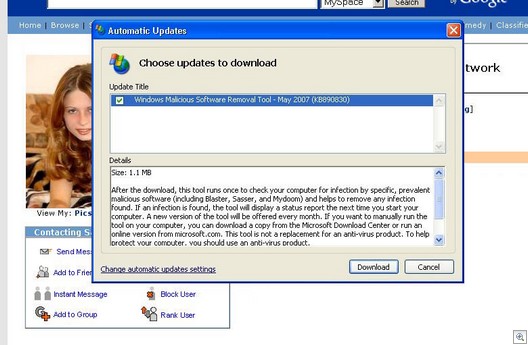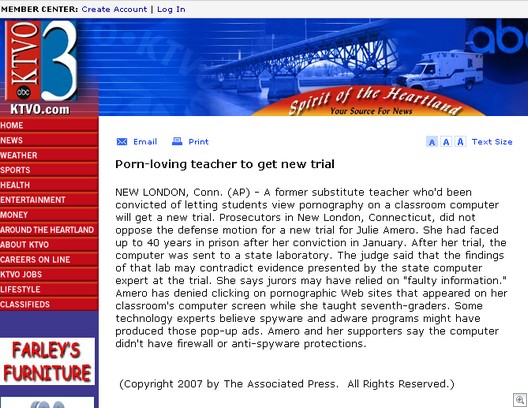For a long time, the battle over which is the best operating system has been a three-way one. The vast majority of computer user still depend on some version of Windows, but the market share for Linux in all its varieties has grown over the years. And there is an even larger (although still small) following for the Macintosh.
Here’s the way it’s broken down as of May 2007, according to the Market Shares web site run by Net Applications: Windows XP currently enjoys a little over 82 percent of the market, with other Windows operating systems making up another 11 percent or so.
Macs come in second with almost 9 and half percent (includes both MacOS and MacIntel), and Linux – despite open source advocates’ best efforts – is reported with less than 1 percent of the market. The numbers don’t add up to 100 percent because a few other specialty operating systems, such as Hiptop (for mobile phones) and PSP (for gaming consoles) are also included in the statistics, but the top three dominate desktop computing.
The web browser is arguably the most used piece of software on most computers and similarly, the browser wars have been primarily a battle between three contenders: Internet Explorer (with almost 79 percent), Firefox (with just over fourteen and a half percent) and Safari (with almost 5 percent). There are many other browsers available, including the one-time favorite Netscape, Opera, Konqueror and versions of Mozilla, but the rest all show under 1 percent of market share.
Safari has, up until now, suffered a disadvantage in this contest. Since it ran only on Macs, and Macs are on less than 10 percent of computers, most users weren’t able to run or even try the browser.
Thus, most folks, when you say “alternative web browser,” think only of Firefox. But now, if you happen to like the Safari web browser that comes with Mac OS X, but prefer to use Windows (or have to at work), now you can take a Safari without switching your OS. Apple has just released a version of Safari for Windows.
Some pundits warn that it’s just a ploy to lure Windows users over to the Mac. Others applaud the ability to use Mac programs they like without having to switch platforms. Some speculate the Safari for Windows release will hurt Firefox more than IE. Whatever your opinion may be, it was downloaded more than a million times in its first two days of availability. Somebody must be interested.
This release is a beta, and it was announced by Steve Jobs at the Worldwide Developers’ Conference 2007 last week. The Windows version has the safe features as the one that runs on OS X. Apples claims that Safari runs twice as fast as IE and significantly faster than Firefox. Since the need for speed seems to be a common trait of computer users, this makes Safari look like an attractive alternative.
It also boasts some interesting features such as SnapBack, a button that lets you instantly go back to the top level of a web site after browsing deeply into it or create an anchor point to snap back to after browsing through many links and sites. And it has a security feature called “private browsing” that lets you turn off storage of search results, cookies, site history, download history and other normally cached information, instead of having to erase those caches after the fact.
I wanted to find out for myself. I always install multiple browsers, for several reasons. Some web sites won’t render properly (or at all) in one browser but look fine in another. And I create web pages, so I like to take a look at my own pages in different browsers so I’ll know how others are experiencing them. I currently have IE 7, Firefox and Opera installed on my primary desktop computer and I was eager to add Safari to the collection.
Download and installation of the beta took only a few minutes, but I made sure to create a restore point first, just in case. It was pretty non-intrusive; it did install an icon on the desktop, but interestingly it didn’t open the browser after installation. I clicked the icon – and immediately got a message that the program had stopped working. Subsequent attempts rendered the same result. Although it was advertised as being for XP or Vista, my installation of Vista apparently didn’t like it.
I tried changing the compatibility settings on the Safari.exe program to run in XP compatibility mode. That’s worked for a number of programs that didn’t work on Vista right off the bat, but it had no effect here. Next I tried running as an administrator. That didn’t work, either. Okay, maybe – even though it didn’t say so in the installation instructions – it required a reboot. I closed everything and restarted the computer. Still no Safari for me.
Not one to give up that easily, I next tried to install Safari on a couple of XP machines – first one that belonged to my Windows domain and then, when I was unsuccessful again, on one that wasn’t a domain member. This time I got a little further – Safari detected my proxy server and asked for my credentials. I had high hopes. However, after I entered them, I got the XP dialog box telling me that Safari had encountered a problem and needs to close.
If I canceled the proxy dialog box, I couldn’t access any web sites, but I could examine the Safari menus and Help files. Unfortunately, the Help files provided no help for my problem. The good news was that the installation attempt didn’t cause any problems for the OS or other programs, but darn it, I had used Safari on OS X and wanted to get a chance to actually use it to view web pages on XP or Vista.
Tom started mulling over the problem with me, and we came up with one last idea, based on the request for proxy credentials on the XP computer. Maybe the proxy authentication wasn’t working correctly. He headed upstairs to the server room and turned off proxy authentication on the ISA Server that’s installed on our network edge. Sure enough, Safari then worked fine.
It’s not a very practical solution. For security purposes, we’re not going to leave authentication turned off just so we can use the Safari browser. But at least we did track down what was causing the problem, and I got a chance to take a brief look at the browser.
The interface is the familiar OS X look (which I rather like). Its window frames are not transparent in Vista, though. And yes, it is fast. In side-by- side tests, it opened most pages more quickly than IE and Firefox, but not by a lot. In fact, the other two browsers sped up a lot when proxy authentication was off, too.
I had one immediate complaint: when you click in the address bar, it doesn’t highlight the whole address as IE and Firefox both do, so you can type in a new one without dragging to highlight and delete the old one. Minor, but annoying. Also, as with all OS X programs, you can’t resize the window by just grabbing the edge anywhere; you have to grab it at the bottom left corner. That can take some getting used to.
As promised, it imported my IE bookmarks without asking (not sure if that’s good or bad). The way it handles bookmarks is interesting; there is a bookmarks tab that you can choose to show or hide. SnapBack also works as described, and I think I could get to like that feature.
Note that the initial release had some security problems, but Apple released an update on Thursday (June 14) to fix the vulnerabilities. Be sure you have version 3.0.1. If you have the Apple Update software installed, it’ll be pushed to you through that. And you may want to read this article from Larry Seltzer that discusses the “halo effect” before installing Safari.
If you still want to give it a try, you can download the Safari beta here.
Let me know how you like it and whether you encounter any problems running it on Windows. Also tell us: what’s your favorite web browser, and why? Do you use more than one browser? What features would you like to see on the ideal web browser?
Deb Shinder
 A mother (who is also a former cop)
A mother (who is also a former cop) 






